Heuchera, ‘Coral Bells’ will wake up your yard. Your neighbors will be envious!
I’ve written about Coral Bells before but I’ve got some new pictures that I just have to share with you. These are some of the coolest (I know, saying “cool” shows my age) plants that I’ve ever added to a landscape. And there are so many different kinds.
Don’t get all caught up in “Hey Mike! What variety is that one?” Because . . . I probably don’t know, I’m still learning these and since most of them are patented I’m not propagating them at all. Which means that I am certain to forget which ones I planted in my landscape. “the old kanoggin ain’t what it used to be! I forget.”
I just like them a lot! Knowing which variety is which won’t help you because they are kind of hard to find and when you do find them you’ll be at the mercy of what your local garden store has in stock. Just buy some of each!
It sure doesn’t look like it yet, but I planted five different varieties of Coral Bells in this bed in my yard and I used nine of each variety. In a few months after these plants fill out I’ll get another photo and post it here for you. It should be awesome!
Wanted! People who would like to get paid
for growing small plants at home!
Approximately twelve months later and this bed looks great, the Coral Bells filled in nicely.
Having grown a lot of different Coral Bells and used them in my landscape in several different places, the one that impresses me the most is Snow Angel. Beautiful Variegated leaves with bright pink flowers. Tough as nails, easy to grow and propagate via division.
People like me are always looking for small plants that they can buy and
we buy hundreds at a time from people just like you.
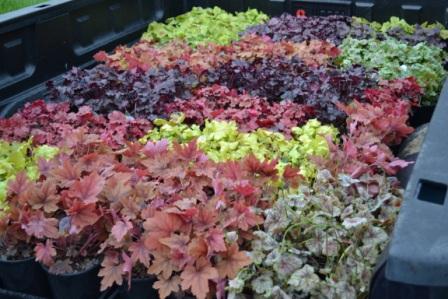
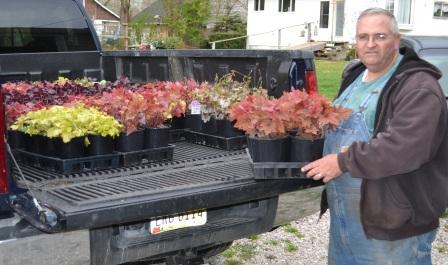

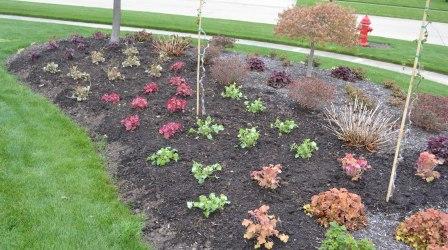
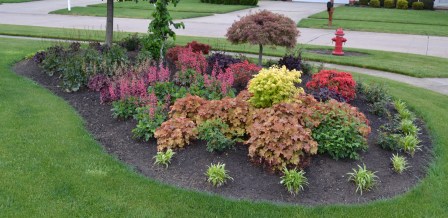
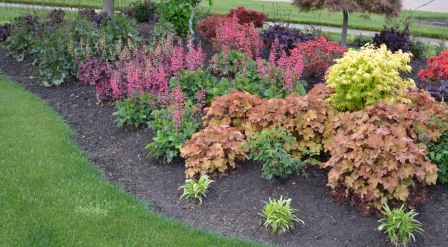
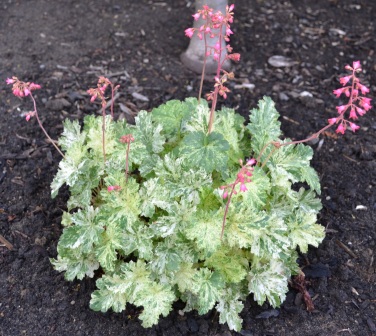
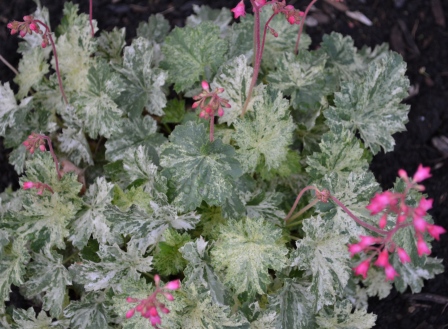
Thanks for a nice article! Most of these beautiful plants are patented as far as I know… so I am wondering how do you divide them? I mean isn’t it prohibited? If there are some non-patented, what are their names? All I can find are patented…
Natalie,
You are right, you cannot divide the patented ones, it’s against the law, even for personal use. But there are many that are not patented but they can be tricky to find. I just bought 80 snow angel in our members area, http://backyardgrowers.com/join, and I’m looking for Marvelous Marble and a few more.
Thanks for your reply! But it’s ok to propagate them with seeds, right? Even the patented varieties? Is it hard?
Natalie,
They are pretty easy from seed, but most will be purple but you never know for sure.
I see. thanks!
If you bury a stem fro a Cora Bell that is still attached to the plant itself and leave the leaf at the end sticking out, will the stem root?
Ron,
More than like it will. You can also root them by one of these means, http://mikesbackyardnursery.com/2015/01/easy-summertime-plant-propagation-techniques-can-home/, but many are patented, you have to be aware of that and not propagate patented plants.
Thank You Mike,
Your videos are great!
Lovely information. Thank you!
Wow! Very beautiful, I love Coral Bells.
Thiis offer was posted some time ago. I was just cleaning out my mail box and came across it. Is the offer still good?
Warren K. Smith
Hey Mike, Al here.
I am a recently retired guy who is not quite ready for the rocker and mall walking. I’d like to try my hand at back yard farming. The Heuchera plant has caught my attention. In going to the local “Bark and Garden Store”, I found the price is somewhat prohibitive. So I thought I would try and grow my own from seed. The initial challenge is I can only find seeds for the varieties that have the least interest for me. Why is that? If I were to buy the larger expensive ones from the nursery, could those plants be split in half or thirds out of the gallon container?
Thanks for your response.
Al
Al,
Heuchera can be divided just as you would any other perennial. If the one that you buy happens to be patented, they don’t want you propagating their patented planted, even for your own use. Just thought I’d throw that out there.
mike been reading about the heuchera flowers they are
beautiful I do not think I ever heard about them here in
Alabama but going to try to find some maybe I can find someone to put them out for me love that garden of them
you have please KEEP UP THE GOOD WORK LOVE INFO I GET OUT
OF YOUR NEWS. THANKS MIKE.
CLYDE HOLMES
I love these plants! In my opinion, you can never have too many heuchera or hosta.
I know that you are not legally able to propagate patented plants, and most of the new varieties are, BUT.. I’m going to tell you that you almost have to propagate at some point because the babies the plant produces are not rooted and are above the ground. That’s why people dig them up every few years and plant them deeper, so the babies develop roots. Eventually the middle mama will die, so you need those babies to sustain your collection. What I do is pluck off babies (I love that you don’t need a shovel or anything) and remove all but a couple baby leaves. I stick them in soil near the mama and keep them moist. And that’s it! These plants are so easy and so rewarding to grow.. I just wanted to mention propagation because I’ve had people tell me their heucheras always die eventually and well.. they do. But before they are done they will leave that legacy of babies, that hopefully you’ve planted either separately or while it’s still attached to the plant.
Another thing is, my heuchera don’t like to be mulched near the crown. I keep the mulch pulled back from the plants a bit.
Hope this helps someone!
Mike, I need an application to join the Backyard Growers Business Center.
Mike, I’m thinking these would go nicely under the redwood tree in my front yard (Sacramento, CA area). It’s pretty shady there most of the day, even though the temperatures can get up to 100+ for a week or more at a time during the summer. Any thoughts on how to help ensure that they would grow well there in spite of the heat?
I have about an 18″ ring of rocks around the trunk of the tree, and have planted pink oxalis just at the edge of the rocks. The Coral Bells would look nice in an outer ring. I was planning on using Hosta for that, but like the looks of the Coral Bells better.
Kathy, if you like Amethyst Mist, you’ve got to try ‘Berry Smoothie’ coral bells. It truly is the color of a strawberry smoothie and is a standout in the shade garden.
Mike,
Ienjoy reading your e-mails and videos
Ihave one kind of coral bells given by a friend when she moved out of san francisco.The plant seems unhappy in a pot so tranferred it in the ground I am in SACRAMENTO cA.zone 9 I planted it underneath my roses ,and the coral bells are just blooming red-orange flowers love it!
have another topic..have lot of plants growing from the pit i.e apricot,peach.I just throw the pits and they keep growing!!so pull them out and throw them away.I was told they are no better than the mother tree.How can I keep this plants?I feel bad throwing them.Some of it I place in a 10 gallon pot and give them to friends who would like shade tree
Have lots of Hawaiian ginger rhizomes in white and yellow flowers..any body would like them?Seems like a waste to throw them away.
Love to hear your thougts about my plants
Espie
Espie,
When grow fruit crops from seed you never really know for sure how they will do as far as producing fruit is concerned. Some will perform really well, others not so much. Most fruit crops are produce though budding which creates an exact clone of the parent plant.
I just wanted everyone to know that you can grow Coral Bells from seeds. When the flowers turn brown collect the seeds. I start them indoors in the winter. I started out with only a few and now I have tons of them. Love the pictures Mike. Keep up the good work.
Thanks Kitty. I know they grow from seed but I’ve never tried it. I need to get on that.
Succulents also mix in very easily with Coral Bells as they are drought tolerant and the colorings are very compatible with Huecheras and you also don’t have to “pinch back” or prune for winter the succulents. Although Sedum does have it’s long stems that wilt and I just go along and literally pull them away when they turn brown. Very easy maintenance. There are many succulents that can complement these Coral Bells.
I planted coral bells last year around a large fountain and could not believe how they multiplied this year. So good to separate and plant in other beds around the yard!
I planted coral bells for the first time last spring (2012). So glad I did because they’re beautiful this year. I planted Root Beer, Cajun Fire, Amethyst Mist and Palace Purple. So far, Amethyst Mist is my favorite; the deep colors are gorgeous.
update please?
I can’t wait to get your system and get started. Will I have time to get started and have anything to sell by spring? I am in Northwest Mississippi and have mild winters.
How does one know if a plant is patented?
Mike,
If you are buying plants from a respected and professional grower all patented plants should be marked as such when you buy them. However, they are not always marked as such and the responsiblility still falls on you to make sure you are not propagating a patented plant. What you should do is look for the plant using the wholesale sources in my system http://freeplants.com/wanted.htm to see if they show it as patented. Reputable wholesale suppliers are very good about making this perfectly clear. Others? not so much.
Hi… the Coral Bells are great…I have decided to dedicate most of my front sidewalk garden to coral bells. I am also a big fan of Hostas. Beautiful and very little maintenance. This summers drought here in Iowa did a number on a lots of my plantings but not my Coral Bells and Hostas.
They are so easy to take care of and so much to enjoy.
Sandy, not in my California garden. The snails come from blocks away to chew up the hostas. I need a greedy duck!
..Yes, i see your Huechera-Coral Bells Assorted color small plants and it’s really interesting…
Hi Mike..How about an updated photo of those Coral Bells in the mass planting? Thanks for all you share!!
Wendy, I was just looking at those coral bells this afternoon and they are doing great but they haven’t grown a lot. It’s been a challenging growing season, but I’ll get a nice picture when they fill in a little. I’m getting ready to do another mass planting at the nursery, and these will be in a shaded area and they will be quite happy there. Give me time, I’ll share what I have!
I have been a fan of coral bells since growing Bressingham from seed 19 years ago. I now have about 43 varieties and like Mike I probably can’t remember half of the names. All I know is that each summer I make the rounds of all the garden centres in my area (SE Ontario) looking for new ones. And I love the fact that in the fall, when the first frost hits and all my neighbours gardens die immediately, my gardens are still full with Coral Bells.
Hello Mike, I really enjoy all of your emails. I have a question though, I presently live in Bahrain, and have tried growing different plants, most of them died. Outside of the obvious heat/sun issue, what can I do to improve the soil? Love to be able to plant some fruit trees and flowers, but what will survive and produce in this weather and sandy soil?
Renata,
Your soil can be greatly improved by tilling in rotted manure such as cow manure. That’s makes a huge difference in how well plants do. Other than that, a water & shade help a lot.
mike,i dug mine from my late moms garden. both are planted in full sun. i mixed garden soil with my clay soil. what else can i do????( i lost her 5 months ago.)
mo. girl….
plus she has beautiful roses. shrub and climbers. what my chances of moving them to my yard??????? help!!!!!!
Hi Cynthia, wait ’til your mom’s roses go dormant this fall to dig them. In the meantime get some compost going to put in the bottom of the planting hole. I have found rabbit manure works really well to break down kitchen scraps quickly. Chicken manure is really hot. Careful not to burn the tender roots!
Mike,
How did you build that mound?
Thanks,
Darrin
Mike, I really enjoy all the tips that you give me for growing and making money. I live in Central Oregon and am wondering if the corral bells will grow here??
Teri, of course they will. Oregon has a great climate for growing all kinds of plants.
OK mike I see your addiction and I raise you one. I too have this same addiction and I’m a addiction counselor. Tell me if you can’t split the coral bells what will you be doing with this many. How do you make money? just buy by the semi load to get a deal and sell for penny’s more?
Marge, most of the Coral Bells in the photos are patented which means that I cannot propagate. But as a member of the trade I can buy them for at least 50% of retail customers have to pay. I also have a one of our Backyard Growers that sells them really cheap in a smaller size. Details about all of that here: http://freeplants.com/wanted.htm
Mike, you must be a Saint as it appears no one reads anymore as you were asked the same questions again and again. You must really love plants (and people)…. LOL. I need to get your course ordered pronto as I have picked up so many tips from you already. As a landscaper I have been bringing sick plants home for years and piddling around with divisions of hosts and lariope. I need some white variegated lariope plants in my little nursery. Real glad I found you.
David,
It will be great to have you on board. Growing plants would be perfect for you, plus you’ll pick up a great deal on marketing as well.
Iabsolutely am hooked on huecheras!! Lime ricky an old one is spectacular, and it divides it self 2 x in a summer….oh, and peach flambe—oh, oh I go crazy when i see them. As you say, they are not available everywhere, but I have found some online…don’t get me started!
hi Mike, I REALLY enjoy all your emails and info. I do like coral bells and have tried different ones but never have any luck, had them mostly in shade, so I kinda gave up. I live in northern wis.
Mike: The pictures are lvely and have given me some great ideas. What is the hardiness zone.? We are in Southern Vermont with clay soil. WIll they work well here?
Kathleen, good to zone 5 for sure, some might work in zone 4. They’ll do as well in clay as anything, but ammending clay soil is always a huge help.
I have been reading about heuchera and have seen that they should be planted in shade but I noticed that you planted them in sun. So I am wondering about how much sun they can take and remain healthy. It seems there is the same questions about hostas. so if you have some knowledge on this I would sure appericate hearing it. thanks Mike for all of your advice.
Yvonna, some don’t do well in full sun. Citronel, I think I spelled that correctly, didn’t work for me well at all in full sun. I moved them to partial shade and they did fine. My experience tells the me that those with bright yellow leaves seem to be the most sun sensitive. All of the others have done well for me no matter where I plant them.
Do you find that Coral Bells do best in shade or sun, or is it best to have them planted in morning sun, afternoon shade? I have some and they are so pleasing to look at.
BJ, I just answered this in another comment.
How much shade or sun for coral bells?
I love them too and have 3 sort of growing, but…the deer and elk like them too and I can’t seem to keep them out of anything. So I don’t recommend them if you have a deer or elk problem.
Hi Leona, try covering with black “bird netting” sold as covering for strawberries. We have tame deer strolling the paths at Villa Montalvo, and the silly fawns are tall goats eating everything! The netting keeps them nibbling only the shoots that poke through the mesh.
Oh (Groan here), I love them too, but forgot about them, and just filled my garden with annuals, where ever there are no hostas!I simply cannot go into another nursery/ garden store! Oh whatever shall I do? Because now I am envying and wanting……
Such a pretty presentation Mike. And Thanks for all the emails and videos! So appreciated!
Mike,
Your Heuchera, ‘Coral Bells’ garden looks great, but I have a question.
All our local nurseries (Southern Ohio) say that Heuchera’s don’t do well in full sun … like hostas, they prefer shade.
As your garden appears to be in full sun, I wonder how it will do, come summer??
Also, Regarding your comment about not remembering the particular varieties you have, there are about 300 varieties of Heuchera’s.
Thanks for the photo, and good luck with your business.
Art, in my experience heuchera with bright yellow leaves don’t do well in the sun. Most others seem to do fine. Many of mine get afternoon shade, others sun all day long.
Art,
I have the burgundy/purple leaf variety and it does fantastic in full hot sun.
Beautiful! gotta get me some, I’m making more room to plant in fromt. Always looking for something different to add. Are they perennials? Thanks Mike for all your advise and sharing. I look forward to reading your e-mails.
Yes, Ellen, perennials! More every year!!
A local woodlands garden here in Spartanburg, SC (Hatcher Gardens) has lots of heucheras and tiarellas all winter long under the trees. They seem very happy and really make the woodlands glow.
In a California woodlands garden of native plants I saw a huge drift of coral bells in full bloom. Stunning!
Mike,
I’ve enjoyed your newletters, videos etc. They are all very informative and I feel like I’m chatting with an old friend. Keep up the good work and I, too, have just started to grow Heuchera. They went through a touch winter here in Washington State but at least survived, so now we will have to see what they will do this year. Mutch 2 Mutch
Beautiful…do these plants also do well in part shade? I’ve just planted some in a place that only gets morning sun…and I’m hoping for the best..
Arlene, they should be fine there.
I have about 12 Coral Bells right now, 6 varieties and all planted in pots with other plants such as petunias, white alyssum and creeping jenny. They get about half sun and half shade and do beautiful here in NC.
Are these toxic to pets/animals? Thanks.
Look above what I wrote OK?
Mike – I also have several varieties that I picked up over the years at the local Home Depot or Lowes. But each year I find more and more “toupees” – rootless tops that the voles have eaten from below over the winter. I have rescued a half-dozen this spring and moved them to my protected nursery bed but I would really like to find a way to have these, and other yummy vole favorites like Autumn Joy sedum and hosta, from being devoured by these critters! The mild winter didn’t help at all, either. I’ve tried planting in cages we make out of wire mesh and even metal buckets with drainage holes punched all over, but they manage to get in somehow. Do you have any tricks?
Lynne, I’d treat the soil for Japanese beetle grubs at the correct time of year. Kill the grubs, that usually gets rid of moles, voles etc.
Mike what do you treat your lawn with for grubs and when do you treat it i have to same problem. The voles eat everything i put out
Geraldine and Patty:
You need to know when to apply grub worm treatment. The best time for treating grub worms is in late summer or early fall while the grub worms are still small and close to the surface.
For those choosing a more natural grub treatment as how to get rid of grub worms, there are several options available. All of which are considered safe and effective. These include milky spore, neem oil, and nematodes – available at most garden centers.
Milky spore is a disease that can effectively treat lawn grubs and is environmentally safe. Spores are applied to affected lawn areas, infecting lawn grubs as they feed. Once the grubs die and decompose, additional spores are released into the soil, which helps prevent further infestations.
Neem oil is a botanical pesticide containing insecticidal properties. Neem oil works more as a repellant against Japanese beetles and lawn grubs – inhibiting egg laying, growth and feeding. Neem oil is mixed with water (as directed) and sprayed onto affected lawn areas.
Nematodes are also used as natural grub treatment. These tiny, soil-dwelling worms release bacteria into the soil that infects and kills lawn grubs. Nematodes are available in liquid form or mixed with water and sprayed onto affected areas.
I use the Milky Spore…no problems with animals or kids getting sick that way!
Fantastic Mike !!
Wow…This is absolutely TERRIFFIC!! Keep up the “Great Work” and We will all keep watching and smiling and learning. Thanks for all your Inspiration you have given me…Karen.
I have several varieties in my NJ garden. I find they get a bit sunburned and prefer a shady spot. They overwinter beautifully are among the first to get the color going in the garden. With this crazy early Spring, they are already sending up their stems for the beautiful fairy like bell flowers.
I plant them through out my Hosta garden…love them also…
Beautiful! I had no idea they came in so many pretty colors.
Mike, I love these coral bells! I have never yet had any but would like to. I love the different colors.
Mike,
I, too, love huechera, but have a question about dividing them. One I have has made five heads with no root and the plant is looking pretty sad. How do I remove the “plantlets” and still preserve the plant?
Sue, I’m not sure, all I can suggest is to divide the plant and hope for the best. You could also trying rooting cuttings http://www.freeplants.com/homemade-plant-propagation.htm
Please go on youtube and type in Propagate huechera. There are so many videos to help you with both root division and cuttings. I have also been very successful with seeds, but I do try to make sure they’re not crossed.
Sue- Take the whole plant out of the ground to divide it. I divided mine with a knife. Plantlets that have formed around the core can just be cut off with some roots and potted up in potting soil. In my zone 7b garden, I let them ‘rest’ a bit in a pot to get rooted well and then plant them out in the beds. You can reuse the older original plant in the center but when you repot it you need to plant it deeper than it was growing before. Have only tried dividing them in the fall.
I received beautiful coral bell “babies” from my neighbor years ago. They are so easy to grow and divide. These originals are dark green with pretty pink flowers that bloom in May and June here in Northern NJ – I’ve never seen them for sale in our area. I’ve since purchased the light green, burgandy and dark purple varieties and use them all over my landscape – they always look great.
I’ve had Coral Bells for the last couple of years!! I love them!! We are trying to plant our own woods around the house and these plants are wonderful for adding that bit of color needed for ground cover in those highly shaded areas!! Just have to keep my husband from mowing them!! Red flags do wonders until the trees come into maturity!!
I’ll post some photos when I get mine all planted. I love all of the different varieties!
Kathy, that’s great. By July your plants should look fantatic. Congrats on the Emmy nomination!
Mike –
Yes, you’re right – it’s “limelight.” You got me wondering why also, so I had to check. The following is from Wikipedia.com:
“Limelight (also known as calcium light)is a type of stage lighting once used in theatres and music halls. An intense illumination is created when an oxyhydrogen flame is directed at a cylinder of quicklime (calcium oxide),which can be heated to 2572 °C before melting. Although it has long since been replaced by electric lighting, the term has nonetheless survived, as someone in the public eye is still said to be “in the limelight.” The actual lights are called limes, a term which has been transferred to electrical equivalents.”
Thanks for your emails. I love them and have learned a lot. I hope you keep on sending them out!
Sheila, thanks for researching this for me! Now if I only remember the next time I use it.
Hi Mike, I’ve enjoyed your column for a long time and since I am a new Master Gardener for Seneca County wondered if you do group tours and lectures on your operation. I am on the education committee and need to find educational opportunities for our group. I would love to visit either with my group or just myself.
Thanks
JoAn
JoAn, I’m sure that can be arranged. Finally the nursery is starting to look like something. We just started at this new location one year ago, but we were out there planting Japanese maples today and next week for sure. Finally it’s starting to look like a nursery. Each year I invite all of my Backyard Growers to come and spend the day. We all hang out, share backyard growing stories, have a few laughs and we do demonstrations. But I’d also be happy to entertain any group that wanted to visit our humble operation. Thanks for asking. Just Email Duston at the office at [email protected]
I believe I am addicted to heucheras too! In fact, I bought a new one today, one of the crisps. Can’t wait to plant it here in Northern Virginia.
I knew it was the Coral Bells b4 I clicked on the photos. I love them in your landscape but, I live in Central Fla. I do really love many of the plants you feature in the videos and newsletters but just not sure how they would do in the heat here. So many plants at the box stores are said to prefer full sun but from my experience, NOT Florida’s full sun.
Peace!!
Robin, I used to live in FL (for 40 years) and what I would suggest is to plant some native trees like cabbage palms, scrub oaks or wax myrtles so that you get more shade in your yard and then you will have better luck with some of these plants. The hibiscus with the dark green leathery leaves do well, indica azaleas, lantana, antique roses, herbs, liriope, canna lilies, crotons, jasmine, and any tropical plant. You could also try lorapetulum although I did not actually know about those when I lived in FL. Any plant you buy that says “full sun” will do good in morning sun and afternoon shade. You also need to amend the “soil” which most likely is NOT soil at all but sand. You need to mulch, mulch, mulch and you need to basically get used to growing different types of plants than you would elsewhere…like growing plants for foliage rather than flowers and try to get more native plants….learn to love palmettos and lantanas. Maybe try growing orchids. You can also grow mangos in central and south FL, avocados, citrus, pineapples, and pecans. You did not mention what part of FL….north FL is going to be alot different than even central FL and totally different than south FL. I lived in central FL on the east coast. You can also get 2 seasons of vegie growing….start early (like the beginning of February) for spring harvest and also again in August for fall harvest. Have fun and good luck.
I fell in love with these after I saw how bushy my Hostas went. To me, these are mini and containable hostas!
Mike, could you talk about how you made that berm? I really want to do one, but don’t know what all I have I would need to do to make one. I’ve read everything from all black soil to all compost. Do you have any suggestions for the shape?
Lori, don’t over think it. Any topsoil would be fine, but of course the better the topsoil the better the plants will do. At my other place, you can see the photos here; http://freeplants.com/backyard.htm I just piled up soil, most of it gravel from where I dug out the nursery beds, then later I smoothed off the tops of the piles with a small rototiller and the result was fantastic. Never gave a thought to shape. Just piled up the soil with the tractor, then worked on the piles a little with the tiller and presto. I had no shape in mind when I started.
I have a small raised bed with several different colors of Bells and I call it my Calico Garden. I luv it and it is found just off of my patio nesteled between that and my porch area.
do u have any plants i can grow in Mesa AZ. THX
mike, are those bells in the ground already
Love Coral Bells and want to find a good source for autum leaves coral bell.
Hey, Mike; At 72 I can’t get around my yard as I once did – I believe it was made for Mt. Goats. But I love to receive your e-mails and pictures. Your flowers are ALWAYS beautiful. I love them all!
Are Coralbells An annual or perannial and are the full sun?
Diana, they are perennial and some are full sun, some need shade. The ones with light yellow leaves seem to be the most sun sensitive.
I just love the Coral Bells. I have been trying to grow Hostas and daylilies here in Iceland in our short summers. Last year I bought a few Coral Bells and they seem to be very happy, they even seem to be “evergreen”, keep their colorful leaves all through winter. Thanks for the beautiful photos Mike, and remember to post more photos this summer.
I have three coral bells in a shady bed with dianthus,hosta,Istilbe, canna and azaleas. This year the cora bells and been outstanding with huge healthy leaves. I am loving this bed. It is the happiest bed on my property.
I’ve always like coral bells. Can you suggest some for a spot on the north side of a house under a pine tree? It’s very shady and dark there.
THANKS
What size is the raised garden bed that you are growing the coral bells in? I have about 15 acres of reclaimed coal mined ground that needs help.
Mike, I think I have the same “bug” you have. I can’t seem to get enough of these beautiful plants. The best part is that they get better every year. I love love love the “Lemon Lime” and “Ginger Ale” varieties. I, too, have a whole bed of them which is a real show stopper.
Oh I forgot to say- would LOVE to see if Coral Bells would grow in my yard. They look awfully pretty and love the different colors. That’s what I want in my front yard an array of colors.
Look forward to seeing the picture- maybe I two can send pictures of my yard one day. 🙂
And the fact that their blossoms are lovely and airy and the hummingbirds love them is a real bonus!!
I agree! Be sure to follow up with a photo of what they look like later in the season! I think it is going to be gorgeous when they are in their full glory.
I love coral bells too!
Love Coral Bells and the way you have this bed mounded in the center. Look forward to future photos as these mature.
I have these planted under a pine tree right as you pull into our drive-way, I planted the dark burgandy ones and they look so lovely. My husband just recently cleared out under a cedar tree and that looks like it might be my next spot. I think I may like them as much as you do!
just want to know if your corabells are still doing good under your pine trees. Bought me some today. I wanted something different than the hostas
Hi Deb, I found this blog from Mike from June 2013, he mentioned Coral Belles: I really like the Coral Bells in my landscape because they truly are the most care free plants I have. All summer long I do little to them. Pam goes out once a year and removes the spent flower shoots, other than that we don’t touch them. Come fall they go dormant, but really don’t look that different. Unlike other perennials that completely collapse and dry up at the first sign of frost, Coral Bells don’t do that. They pretty much look the same in the winter as they did at the end of summer. But come spring you don’t even have to remove the old growth. The new growth Emerges and completely engulfs the entire plant to the point that you can’t even see the old growth. Care free! That’s what I like.
http://mikesbackyardnursery.com/2013/06/citronelle-coral-bells-heuchera-villosa-citronelle/
OMG! You are Amazing! Simply WonderFull Ideas.
I’m looking at my three varieties of Coral Bells as I write. They share a bed with Lungwort at the base of a Dogwood in my front yard. They really loved our “non” winter in Western NC this year. Just saw them for sale at Bullington Center in Hendersonville and got my first one at BB Barnes in Asheville. Looking forward to seeing your new bed when it takes off.
I love your garden but I was wondering if they would look good mixed up. I love mixing my flowers so it looks like a wild garden.
Hi Penny,
I love coral bells with my knock out roses , or whatever your favorite roses are ! I have some in sun , and some in shade ….basically it changes the need for watering ….so …if watering is a problem , put them in partial shade ! The foliage is pretty even when not flowering , which adds to their attraction . Good Luck , S
Mike, talk about timing. I just was telling my husband this week that I want to dedicate a garden strictly for these beauties. Just when I decide ‘this’ one is my favourite, then another is brought to my attention replacing it. Outside of Hostas, I think I have to say the Coral Bell has got to a top favourite of mine..:)
Love the photos of all the different coral bell plantings. beautiful! I am not sure what you mean by this phrase: “since most of them are patented I’m not propagating them at all”. I do not understand why you are not allowed to propagate a plant that has been patented…. do you mean to sell or to use as an item for your own garden? Thanks for the clarification ahead of time.
Mike, These look really nice the way you planted them, can’t wait to see a picture later when they have grown.
I luv your email’s and video’s and they help out a lot.
Thanks
Mike you truly have a green thumb. I have been working on my garden for about 4 years and FINALLY have seen the fruits of my labor! lol After working in the yard for hours at a time, year after year. It took alot of trial and error to learn that you MUST first start with good soil which I didn’t have. Thank you for all of your videos and tips- I might be a gardener thing after all. 🙂 Thanks again for all you do.
I love Coral Bells. Try Sweet Tea at Sunrise. It is so beautiful. You will be amazed at the variety of colors in the leaves of this plant!
do you have a picture?
are Coral Bells annual or perinnal? thanks!
Phyllis, Coral Bells are perennials. I don’t even cut mine back. I just leave them for the winter since they are almost semi evergreen, then come spring the new growth comes up and engulfs last years old growth.
Debbie, Can you please tell me what Zones these Coral Bells prefer? I live in Southern California and have Zone 8-12 and upwards. Ive never seen these types of plants and their so beautuful. Thanks for you reply…Paul
Paul,
I’m pretty sure they would not like your hot climate. Many of them prefer to be in the shade even here in Ohio.
They sell them here in Nashville, TN. They do fine and it gets a lot hotter here than it does in California in the summer. They sell them as perennial shade plants here. I would think they would make it there. The only thing might be the soil. If your soil is sandy, you might want to amend it some with some rich dirt. I only say that because here and where Mike is, the soil is very different. I have NO sand in my soil…only clay. Don’t know about Mike, but I doubt the soil is very sandy. Give it a try. I think you will be surprised. They might even bloom longer there. Who knows?
Anonymous, it gets into the 120’s here in California and that’s not always a “dry heat”. I know it gets very humid in TN. That tends to raise your temps a bit. They do sell coral bells here in Orange County CA. They are truly beautiful in bloom.